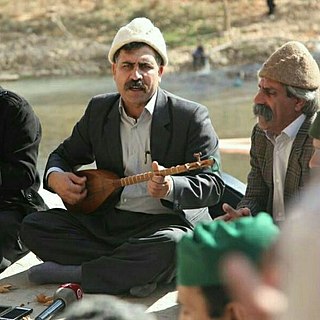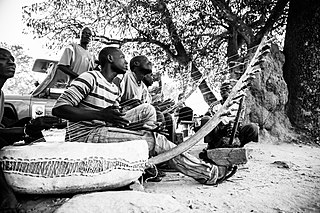
The harp is a stringed musical instrument that has individual strings running at an angle to its soundboard; the strings are plucked with the fingers. Harps can be made and played in various ways, standing or sitting, and in orchestras or concerts. Its most common form is triangular in shape and made of wood. Some have multiple rows of strings and pedal attachments.

The lyre is a stringed musical instrument that is classified by Hornbostel–Sachs as a member of the lute family of instruments. In organology, a lyre is considered a yoke lute, since it is a lute in which the strings are attached to a yoke that lies in the same plane as the sound table, and consists of two arms and a crossbar.

Kāfiristān, or Kāfirstān, is a historical region that covered present-day Nuristan Province in Afghanistan and its surroundings. This historic region lies on, and mainly comprises, the basins of the rivers Alingar, Pech (Kamah), Landai Sin river and Kunar, and the intervening mountain ranges. It is bounded by the main range of the Hindu Kush on the north, Pakistan's Chitral District to the east, the Kunar Valley in the south and the Alishang River in the west.

The Nuristanis are an ethnic group native to the Nuristan Province of northeastern Afghanistan and Chitral District of northwestern Pakistan. Their languages comprise the Nuristani branch of Indo-Iranian languages.

Nuristan, also spelled as Nurestan or Nooristan, is one of the 34 provinces of Afghanistan, located in the eastern part of the country. It is divided into seven districts and is Afghanistan's least populous province, with a population of around 167,000. Parun serves as the provincial capital. Nuristan is bordered on the south by Laghman and Kunar provinces, on the north by Badakhshan province, on the west by Panjshir province.

The Nuristani languages, also known as Kafiri languages, are one of the three groups within the Indo-Iranian language family, alongside the much larger Indo-Aryan and Iranian groups. They have approximately 130,000 speakers primarily in eastern Afghanistan and a few adjacent valleys in Khyber Pakhtunkhwa's Chitral District, Pakistan. The region inhabited by the Nuristanis is located in the southern Hindu Kush mountains, and is drained by the Alingar River in the west, the Pech River in the center, and the Landai Sin and Kunar rivers in the east. More broadly, the Nuristan region is located at the northern intersection of the Indian subcontinent and the Iranian plateau. The languages were previously often grouped with Indo-Aryan or Iranian until they were finally classified as forming a third branch in Indo-Iranian.
Âṣkuňu is a language of Afghanistan spoken by the Ashkun people – also known as the Âṣkun, Ashkun, Askina, Saňu, Sainu, Yeshkun, Wamas, or Grâmsaňâ – from the region of the central Pech Valley around Wâmâ and in some eastern tributary valleys of the upper Alingar River in Afghanistan's Nuristan Province. Other major places where the language of Ashkun is spoken are Nuristan Province, Pech Valley in Wama District, eastern side of the Lower Alingar Valley in Nurgaram and Duab districts, Malil wa Mushfa, Titin, Kolatan and Bajagal valleys.
The musical traditions of Central Asia mirror the immense diversity found in the cultures and populations residing in the region. Principal instrument types are two- or three-stringed lutes, the necks either fretted or fretless; fiddles made of horsehair; flutes, mostly sige at both ends and either end-blown or side-blown; and jew harps, mostly metal. Percussion instruments include frame drums, tambourines, and kettledrums. Instrumental polyphony is achieved primarily by lutes and fiddles.
The Katir are a Nuristani tribe in Afghanistan and Pakistan.
Kaffir or Kafir may refer to:

Afghanistan is a multiethnic and mostly tribal society. The population of the country consists of numerous ethnolinguistic groups: mainly the Pashtun, Tajik, Hazara, and Uzbek and minorities of Aimaq, Turkmen, Baloch, Pashai, Nuristani, Gujjar, Brahui, Qizilbash, Pamiri, Kyrgyz, Sadat, and others. Altogether they make up the Afghan people.

The term Tanbur can refer to various long-necked string instruments originating in Mesopotamia, Southern or Central Asia. According to the New Grove Dictionary of Music and Musicians, "terminology presents a complicated situation. Nowadays the term tanbur is applied to a variety of distinct and related long-necked lutes used in art and folk traditions. Similar or identical instruments are also known by other terms." These instruments are used in the traditional music of Iran, India, Kurdistan, Armenia, Afghanistan, Azerbaijan, Pakistan, Turkey, Tajikistan, Kazakhstan, and Uzbekistan.

African Harps, particularly arched or "bow" harps, are found in several Sub-Saharan African music traditions, particularly in the north-east. Used from early times in Africa, they resemble the form of harps in ancient Egypt with a vaulted body of wood, parchment faced, and a neck, perpendicular to the resonant face, on which the strings are wound.

The çeng is a Turkish harp. It was a popular Ottoman instrument until the last quarter of the 17th century.

The ancient veena is an early Indian arched harp, not to be confused with the modern Indian veena which is a type of lute or stick zither. Names of specific forms of the arched harp include the chitra vīṇā with seven strings, the vipanchi vīṇā with nine strings and the mattakokila vīṇā a harp or possibly board zither with 21 strings.

The veena, also spelled vina, is any of various chordophone instruments from the Indian subcontinent. Ancient musical instruments evolved into many variations, such as lutes, zithers and arched harps. The many regional designs have different names such as the Rudra veena, the Saraswati veena, the Vichitra veena and others.

Hittite music is the music of the Hittites of the 17th–12th century BC and of the Syro-Hittite successor states of the 12th–7th century BC.

The Anglo-Saxon lyre, also known as the Germanic lyre or the Viking lyre, is a large plucked and strummed lyre that was played in Anglo-Saxon England, and more widely, in Germanic regions of northwestern Europe. The oldest lyre found in England dates before 450 AD and the most recent dates to the 10th century. The Anglo-Saxon lyre is depicted in several illustrations and mentioned in Anglo-Saxon literature and poetry. Despite this, knowledge of the instrument was largely forgotten until the 19th century when two lyres were found in cemetery excavations in southwest Germany. The archaeological excavation at Sutton Hoo in 1939, and the correct reconstruction of the lyre in 1970, brought about the realisation that the lyre was "the typical early Germanic stringed instrument."

Arched harps is a category in the Hornbostel-Sachs classification system for musical instruments, a type of harp. The instrument may also be called bow harp. With arched harps, the neck forms a continuous arc with the body and has an open gap between the two ends of the arc.














